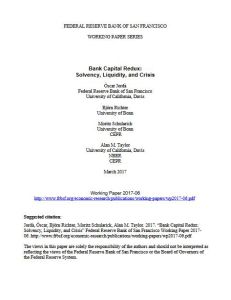Acesse a sua conta getAbstract para obter o resumo!

Acesse a sua conta getAbstract para obter o resumo!
Òscar Jordà, Björn Richter, Moritz Schularick and Alan M. Taylor
Bank Capital Redux
Solvency, Liquidity, and Crisis
FRBSF, 2017
Sobre o que é?
Higher bank capital ratios are not a panacea for preventing future financial crises.
Recommendation
In the advanced economies, financial regulators have targeted capital ratios as an effective tool for averting financial contagion and mitigating its negative impacts. As a result, officials have promulgated banking capital and leverage rules with substantially higher thresholds since the 2008 crisis. But economists Òscar Jordà, Björn Richter, Moritz Schularick and Alan M. Taylor push back on this reasoning by compiling a historical record of data to understand whether such measures can prevent credit shockwaves. getAbstract recommends this powerful report to finance professionals for its deep dive into the intricacies of financial sector engineering.
Summary
About the Authors
Òscar Jordà is an economist at the Federal Reserve Bank of San Francisco. Björn Richter and Moritz Schularick are economics professors at the University of Bonn. Alan M. Taylor is an economics professor at the University of California, Davis.




















Comment on this summary